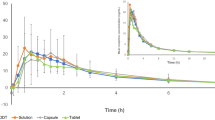Abstract
Objective: To study the plasma concentrations of morphine and its glucuronides to assess the intra- and interindividual variability of the disposition of morphine administered by subcutaneous infusion in cancer patients.
Methods: Blood samples were taken repeatedly in eight patients with severe cancer pain who were being treated with morphine (60–3000 mg per day) via chronic (8–160 days) subcutaneous infusion. Venous blood samples were collected at least weekly and, when possible, on 3 consecutive days after dose adaptation or any other major change in the patients' treatment. Concentrations of morphine and its glucuronides in plasma were measured after solid-phase extraction using a validated high-performance liquid chromatography assay. The stability of the morphine solutions was determined by repeated measurement of the concentrations of morphine and its degradation products in the solutions.
Results: The morphine concentration in the infusion solutions remained unchanged during storage and infusion. The plasma concentrations of morphine and its glucuronides were within the ranges reported in the literature. There was, as expected, a large interindividual variability: from patient to patient, the mean of the normalised plasma concentrations ranged from 0.3 ng · ml−1 · mg−1 to 0.8 ng · ml−1 · mg−1 for morphine, from 1.0 ng · ml−1 · mg−1 to 3.1 ng · ml−1 · mg−1 for morphine-6-glucuronide and from 6.8 ng · ml−1 · mg−1 to 24.3 ng · ml−1 · mg−1 for morphine-3-glucuronide. Intraindividual variability was also important. The residual standard deviation of the mean normalised plasma concentrations calculated for each patient ranged from 26% to 56% for morphine, from 20% to 51% for morphine-6-glucuronide and from 20% to 49% for morphine-3-glucuronide. The normalised plasma concentrations of morphine and its glucuronides did not increase with dose or time, and no explanation for the pronounced pharmacokinetic intraindividual variability was found.
Conclusion: During subcutaneous infusion of morphine, there is a large intra- and interindividual variability of the morphine disposition which could be of clinical relevance.
Similar content being viewed by others
Author information
Authors and Affiliations
Additional information
Received: 5 August 1997 / Accepted in revised form: 8 October 1997
Rights and permissions
About this article
Cite this article
Vermeire, A., Remon, J., Rosseel, M. et al. Variability of morphine disposition during long-term subcutaneous infusion in terminally ill cancer patients. E J Clin Pharmacol 53, 325–330 (1998). https://doi.org/10.1007/s002280050387
Issue Date:
DOI: https://doi.org/10.1007/s002280050387




